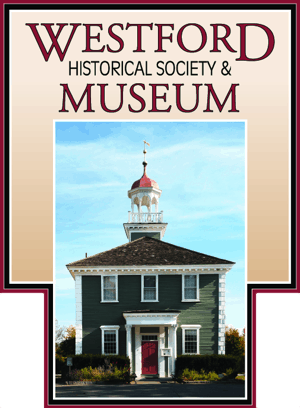The First Half-Century of the Historical Society and Museum: Briefly!
Founded “to study Westford history” and “to stimulate the collection and preservation” of related manuscripts and artifacts and “to encourage research and disseminate historical information,” the Westford Historical Society first met on November 20, 1958, under the inspiration and leadership of Allister MacDougall. An initial group of about 35 members, mostly long-time residents, met in the Fletcher Library. Typically each attendee brought an historical item to share, along with “delicious hot soup,” according to the minutes. To join, one had to apply, be voted in, and pay one dollar.
Five years later, the Society was incorporated under Chapter 30 Section 3 of the Massachusetts General Laws, with Walter Fletcher as chairman, so as to be able legally to accept property. They had already accepted the famous “Boat Stone,” and spent hours discussing the “Burial Stone of a Scottish Knight,” which were to become recurring topics in society operations over the next fifty years.
By l965, the Society had become largely inactive but pulled together in 1968 to hold the First Annual Antique Sale on the Common. Homeless due to remodeling of the library, the group moved to the Tadmuck Club, while noting that the original Academy building would make ideal headquarters when the town no longer needed it as a fire station.
When that time came in 1974, a $7,000 Bicentennial Grant from the state stimulated restoration of the former Academy building, even before its care and custody were officially transferred to the Historical Commission created by Town Meeting in 1975. The Rotary Club and over 200 families and businesses contributed to restore the Academy building, which was dedicated as a Historical Museum in 1976. Forming the Friends of the Museum, Beth Shaw, David Watson. Lloyd Blanchard, Gordon Seavey, John Crisafulli, Alex Belida and at least 100 others over the years initiated and continued this on-going project.
During this period of setting policies for accessioning donations from dolls to antique fire trucks, while handling frozen pipes and lightning strikes to the cupola, the Museum Board and the Historical Society functioned as separate entities, with shared interests. After the initial surge of excitement and support, both struggled with a lack of volunteers and funds. In 1988, they gained possession of the dispatcher’s cottage next to the Museum, with a prophetic warning not to put heavy files cabinets in the center of the aging structure.
Originally they both met in the mornings, often jointly: the Society sometimes met only twice annually. The Museum Board meanwhile struggled for years to purchase and learn to use the computer to keep track of accessions. Programs were held on the history of toys, farms, trains, even the Big Dig. In 1990 the Junior Women’s Club started third-grade tours of Westford and its museum, which has a tradition of working closely with students at every level. As a repository of primary sources, including those of the Westford Academy’s more than 200 years of history, the museum attracts researchers from all over the country. A graduate student from the University of Lowell who started as an intern at the museum went on to become one of its first paid part-time curators.
Over the years, suggestions were made to merge the Museum Board and the Historical Society officially. In the 1990’s, the Society’s assets were transferred to the Museum Board but kept in separate accounts to maintain the Society’s tax-free privilege, and the administrative organization was thence officially called “The Westford Historical Society and Museum,” and finally, “The Westford Historical Society, Inc.” as it began. The Westford Historic Commission retains care and custody of the buildings and receives a budget from the town to maintain them and pay utilities.
Naturally the historical Society had been affected over the years by the dramatic growth and changes in the population of Westford, and had to struggle to attract younger working couples who moved onto the old farms and orchards, often with no knowledge of local history. To draw people in to the museum, a highly successful folk concert series was started in 1998. President Ken Tebbetts, Acquisition Chair Lizette Greaves and Treasurer Mike Harde gathered people and funds to manage the 1999 acquisition of the Parish Hall next door, now leased to the Parish Center for the Arts. Recurring favorites such as the Barn and Attic Sale, a Skinner (Auction House) Appraisal Day, genealogy classes, St. Distaff’s Day, a Holiday Celebration for town employees, two re-publications of Hodgeman’s History of Westford, and February book discussions continued to bring people into the museum. So also did speakers and special exhibits, which utilized teams of volunteers under dynamic long-time directors like Marilyn Day.
The spirit of the twenty-first century has entered the Society with the founding by Andy Norander and Jim Bogue of the Westford Academy Museum Club. Further evidence of modernity: the Society has acquired several historical Westford artifacts which were found on e-bay by alert citizens!
